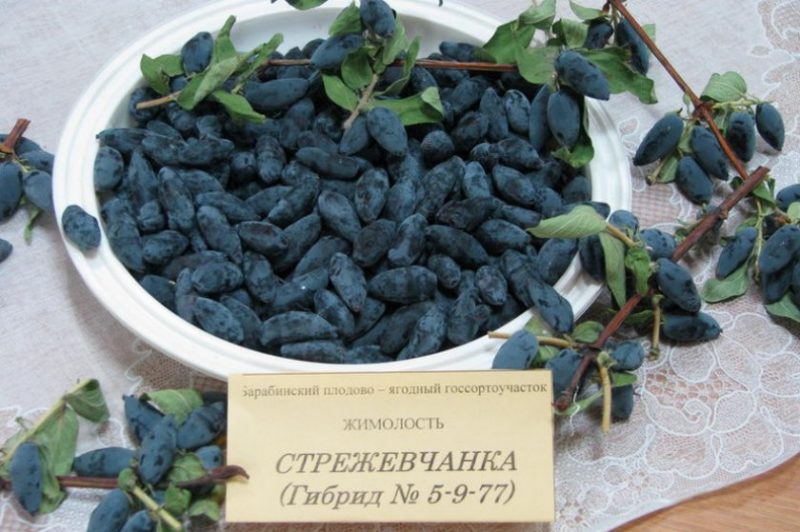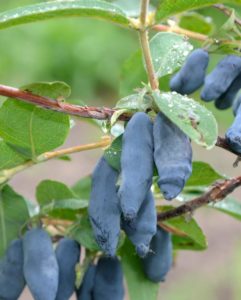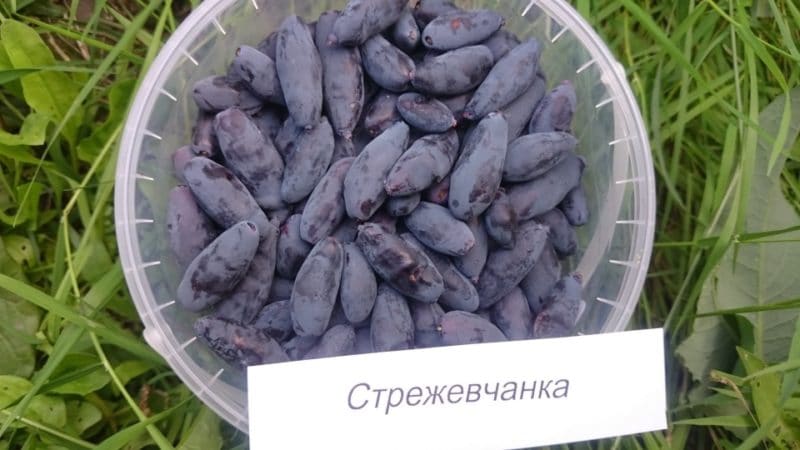Large-fruited frost-resistant honeysuckle variety Strezhevchanka
Among honeysuckles, many early and late varieties are known. One of the latest achievements of Siberian breeders was Strezhevchanka, intended for cultivation in the West Siberian region.
Description of the honeysuckle variety Strezhevchanka
The variety has a significant advantage in the form of early flowering and fruiting, as well as high yield during the season.
This is a winter-hardy, drought- and disease-resistant honeysuckle with a high sugar content in the fruit.

Origin and development
The variety was bred at the Federal Unitary State Enterprise "Bakcharskoe" in the Tomsk region in 2012.
Strezhevchanka was included in the State Register in 2017. A patent for this variety was issued in 2014.
Characteristics, description of appearance, taste
This is a mid-early variety for universal use. The bush is medium tall, up to 1.8 m, medium spreading. The shoots are erect, slightly curved at the apex, with brownish-white matte bark.
The buds are of medium length, the axillary ones are curved towards the shoot. The leaf blade is medium-sized, slightly pubescent, matte, rich green, oval in shape. The base of the leaf blade is wedge-shaped.
The berries are large, spindle-shaped or elongated oval, blue in color, with a slight waxy coating. The skin is smooth and dense. The berries taste sweet and sour. Shedding from the bush as it ripens is average.
Tasting score – 4.9 points (out of possible 5).
Features of application
Honeysuckle has a universal purpose and can also act as an ornamental plant. The berries are edible and can be used both fresh and processed.
In terms of transportation, they are not very good, because as they ripen and overripe, they become increasingly soft.
Productivity and fruiting
The yield from one bush can reach up to 3.5 kg. Fruiting of young bushes begins from 2-3 years of life and practically does not decrease as the shoots age.
On old branches, the number of flowers and berries may decrease as the bush thickens. The highest yield comes from 3-8 year old shoots.
Important! For good yields, it is important to provide pollinating insects with access to flowers.
Ripening period
Flowering occurs in mid-May and lasts 2-3 weeks. The first berries ripen in the first half of June.
Resistance to diseases and pests
The variety demonstrates good resistance to the most common diseases and pests in the West Siberian region.
The main measures to protect plantings come down to preventive treatment of the area.
Resistance to cold and drought
The variety can withstand cold temperatures down to -40°C and spring frosts down to -8°C.
With regard to drought, Strezhevchanka also shows good endurance, but is unstable to high temperatures for a long time.
Suitable regions
The variety is recommended for cultivation in the West Siberian region: Altai Territory, Novosibirsk, Tomsk, Omsk regions, and the Altai Republic.
Shoots and buds are resistant to frost and prolonged drought.
Honeysuckle Strezhevchanka: advantages and disadvantages of the variety
The main advantage of the variety is its short ripening period and long fruiting period.
In some cases, under favorable climatic conditions, it can bloom twice per season, providing higher yields.

Other advantages of the variety include:
- large berries;
- excellent presentation;
- high taste characteristics, according to the tasting mark - 4.9 points;
- convenient height and shape of the bush for harvesting;
- unpretentiousness in relation to the soil;
- high frost resistance down to -40°C.
The disadvantages include:
- low transportability (ripe and overripe berries are easily crushed and wrinkled);
- strong dependence on the presence of pollinating insects.
Difference from other varieties and hybrids
The variety is characterized by a short ripening period (about a month passes from the beginning of flowering to the first harvest) and increased resistance to frost.
It is also distinguished by its demands on pollination and low self-fertility.
Agricultural technology
The variety is undemanding to agrotechnical measures and generally demonstrates good survival rates and yields with classical honeysuckle care.
Choosing a place in the garden and preparing holes
The optimal location would be an area protected from the wind with good lighting (small short-term shading is allowed).
The variety grows well on peaty and chernozem soils, gray forest and loamy, sandy loam soils. Honeysuckle can grow in lowlands, as it is considered a moisture-loving plant.
Important! The plant is demanding of the soil only in relation to potassium and phosphorus.
Preparing for landing
It is recommended to plant honeysuckle in open ground in the fall to provide it with a temporary state of dormancy and good adaptation to a new place.The best predecessors are grains and legumes.
Important! The worst predecessors are gooseberries, currants, cherries.
Bushes are planted at a distance of 3 m from each other and at least 1.5 m from other crops. This is necessary both to protect plants from pests and to simplify the care of bushes.
Before planting, the soil is cleared of weeds, loosened and acidified or alkalized depending on the initial pH.
Soil requirements
Strezhevchanka develops well in almost any soil. Sandstones will provide maximum access to mineral elements, and alumina helps retain moisture.
The variety is also unpretentious in relation to the acid-base balance. The optimal indicator ranges from 5.5–6.5 units, but deviations in one direction or another will not become an obstacle to normal growth and fruiting.
Dates, scheme and rules of planting
Bushes are transplanted into open ground in the fall, usually in the second ten days of October. With early frosts or warm autumn, this period may shift.
For planting, prepare a hole 35-40 cm wide and deep within 3 days. Turf, sand or small pebbles are laid on the bottom to ensure good drainage.
The layer should be at least 5 cm thick, with a high groundwater level - up to 10 cm. The drainage is sprinkled with a soil mixture consisting of compost, ash, vermicompost and superphosphate. For 20 liters of compost, use 1 kg of ash and vermicompost and 50 g of superphosphate.
Features of cultivation
Strezhevchanka does not have any special requirements for cultivation.
Maintenance includes regular fertilization and watering. During the growing season, it is recommended to water the plantings no more than once a month, and during prolonged drought - once every 2 weeks.
During fruit ripening, watering is reduced so that the berries do not turn out watery and too soft. Water consumption is 10 liters per bush. Watering is carried out until mid-October.
Reference. After watering, shallow loosening is recommended.
The first feedings are used no earlier than 3 years after honeysuckle transplantation. In the fall, organic potassium and phosphorus are added under the bush. In spring, nitrogen fertilizers are used. A mixture of 5 kg of compost, 80 g of superphosphate and 15 g of ammonium nitrate can be used as a mineral fertilizer.
The crown of the bushes is formed using a standard method. Pruning is carried out in late autumn after sap flow has stopped. Young bushes and shoots are not touched. Branches of 5-6 year old bushes are trimmed. In young plants, only sanitary pruning of dried, diseased or damaged shoots is carried out.
Pollinators
One of the main requirements of the variety is the presence of pollinating insects and bushes for cross-pollination. The best representatives – Yugana, Silginka, The Giant's Daughter, Bakchar giant. They have the same timing of flowering.
Important! Plants also require access to pollinating insects. Under no circumstances should bee, butterfly, wasp or bumblebee repellers be installed.
Disease and pest control
The fight against infectious agents and pests comes down mainly to preventive measures - treatment with alkaline solutions against aphids, infusions of potato or tomato tops, and wormwood.
If a massive accumulation of insects is detected, treatment with insecticides - “Aktellik”, “Topaz”, “Biotlin”, etc. is recommended.
Preparing for winter
The variety is frost-resistant and does not require special preparation for wintering.
Care before the dormant period includes sanitary pruning, removing old fallen leaves from the soil (pests can overwinter in it), updating mulch and loosening the soil. It is also recommended to fertilize in the fall.
Difficulties in growing
When growing Strezhevchanka, the main problem may be root rotting due to high groundwater levels, low self-pollination and self-fertility.
The first is solved when forming a hole for bushes by laying a dense drainage layer. The issue of self-fertility can be resolved by planting 1-2 bushes of other varieties that bloom at the same time as Strezhevchanka.
Reproduction
Bushes can be propagated by division, layering or cuttings.
For cuttings, 3-year-old strong shoots 15-20 cm long with live buds are selected and cut off from above and below. The upper cut is straight, the lower cut is at an angle of 45°. The leaves are removed and the cuttings are placed under a glass jar in fertile soil. Rooting occurs within 2-3 weeks.
The division of the bush is carried out either in March or in the last ten days of October. The bush is dug up on one side, carefully moving the shoots to the dug side, and the root system is carefully separated. The layering bush is transplanted to a permanent place. The method is considered the fastest for obtaining a harvest, but at the same time the most traumatic for the mother plant.
To obtain layering, the outer shoots of 4-5 years of life are bent to the ground and fixed or buried. It is best to secure the shoots with vertical pegs. The buried shoot is watered with a root formation stimulator. After the cuttings appear, they are carefully separated from the mother plant along with a piece of the uterine shoot and transplanted to a new place.
Harvesting

It is recommended to harvest the crop as it ripens within a week to prevent the berries from falling off and being pecked by birds.
Technical ripeness of berries, depending on the season, can occur as early as the last ten days of May. This usually happens in early to mid June. The best indicators of ripeness are a characteristic dark color with a waxy coating and a sweet and sour taste. Ripe berries are elastic, soft, do not crush in the hand, but also do not require effort to crush.
Before harvesting, it is recommended to spread a film or cloth under the bush and shake the fruit branches. Ripe berries fall off easily, which allows you to quickly pick them by hand. Mechanical assembly is not suitable for this grade.
Tips and reviews from experienced gardeners
Experienced gardeners recommend:
- Do not overuse pruning, especially in young plants. It is highly not recommended to form bushes under 4-5 years old. During this period, only sanitary pruning and removal of shoots damaged and dead during the winter are indicated.
- The berries do not keep well, especially if they were collected by shaking the branches. The fruits should be immediately used for juice, wine or jams, or frozen.
- It is better not to plant bushes after other berry crops. Many plants have similar requirements for mineral composition, so there is a high risk of planting a bush in depleted soil.
Gardeners leave conflicting reviews about Strezhevchkanka honeysuckle.
Anna, Novosibirsk: “Honeysuckle Strezhevchanka is simply created for growing in Siberian conditions. The berries are tasty, do not fall off, and ripen early. Growth and yield are good. The fruits are convenient to collect. The only drawback is that the leaves are prone to sunburn.”
Anastasia, Kemerovo: “The berries have an interesting shape, but I didn’t like the taste. You can feel the tartness.I make jam from berries. But I was pleased with the yield.”
Conclusion
Despite the fact that the variety is very young, it has already established itself as one of the best early ripening representatives for the West Siberian region. Honeysuckle Strezhevchanka is frost-resistant, unpretentious in terms of agricultural technology and demonstrates good yield indicators.
The universal-purpose berries have good tasting characteristics, but are poorly stored fresh.